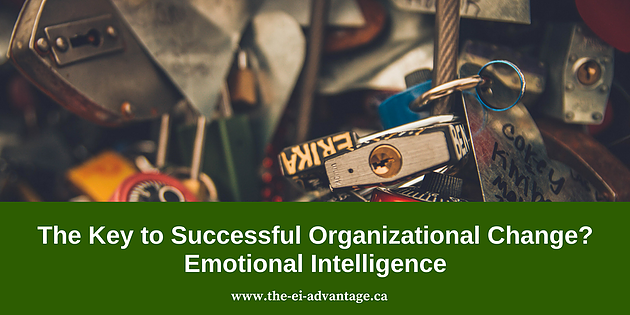Blog
The Key to Successful Organizational Change? Emotional Intelligence
June 07, 2018

How we work is evolving, and workplaces are continuously driven to adapt to arising needs and the changing expectations of today’s modern workforce. As identified by Forbes, in recent years businesses have been focused on areas such as: creating a positive experience for candidates and job seekers; updating overtime and compensation rules; addressing the skill and leadership gap; addressing the shift to a more on-demand workforce, and more.
These changes can trigger strong emotions among staff and team members, which could unintentionally promote close-minded decision making, or tunnel vision that could narrow productive choices and negatively affect workplace environments.
As leaders it’s our responsibility to develop our emotional intelligence (EI) and combine our skills with effective change management strategies to successfully navigate times of change at work and keep productivity high.
Why is EI Critical for Change Management?
Change management is the process of accelerating productive adoption of change within the workplace. Developing your EI makes you a more competent leader and can substantially enhance your team leadership capabilities, and is necessary to help others cope with changes that might be taking place at work, including:
- Organizational restructuring,
- Introduction of new technologies and processes,
- Automation,
- Mergers and acquisitions,
- Globalization,
- Changing business models,
- And more!
Change at work, just like change in our personal lives, can trigger a series of strong emotions as key stakeholders assess and react to how incoming changes will affect their roles. William Bridges, an authority on transitions and change, suggests that change involves multiple stages beginning with confusion, frustration, and denial, which means organizations can expect to see a dip in productivity.
This is where EI comes into play: being aware of our own emotional responses to change can help others around us react in positive and constructive ways. EI is a “must have” tool in every professional toolbox, as it allows us to judge whether our actions are as effective as we’d like them to be, and to assess effectiveness without becoming defensive.
Four Ways EI is Key for Change Management
Mitigating Stress
Stress has a significant effect on mental and physical health, and can cause high blood pressure, diabetes, as well as depression and anxiety. Stress responses can be beneficial during times of crisis, such as avoiding a speeding vehicle by temporarily increasing our visual acuity, focus, and respiration. However, when the stress response is triggered in everyday life it can cause conflicts and potential health problems.
Emotional intelligence allows us to recognize our own stress, and when others are experiencing times of stress. In both cases, we can take proactive steps to help navigate and minimize negative reactions.
Encouraging Agile Learning
A critical aspect to keeping pace with new workplace changes is to be continuously learning, understanding emerging trends, and putting the effort into building positive workplace relationships.
As anyone who has tried something new will tell you: learning requires a degree of vulnerability by being open to making mistakes and the potential for failure. The Harvard Business Review reported that continuous learners who are willing to stretch their comfort zones experience lower levels of defensiveness and negativity, the latter of which can block the ability to learn.
Facilitating Better Decision-Making
Have you tried to make an important decision while experiencing times of high stress and anxiety? If so, you’ll likely recall that making that decision during times of stress was difficult, which applies to workplace decisions, as well.
When our emotions are on high alert the rational part of our brain has a harder time functioning properly, and as a result we might make poor decisions while engaged in a reactive state. By developing EI and applying it to change management we can reduce times of “incidental anxiety” among team members and staff, and ensure that decisions are always made as carefully and rationally as possible.
Ensure Productive Action
Often when emotions are running high responses to change will cluster at one end of the counter-productive spectrum, with impulsivity (reacting without considering all angles) on one end and paralysis (the inability to respond or commit to a decision) on the other.
EI encourages looking at a challenge from multiple angles and taking stock of how each team member might react to, or be influenced by different outcomes. This allows for a “macro level” understanding of any given problem, providing you and your team with the opportunity to make the most well-informed decisions possible.
At EI Advantage, we use the Change Style Indicator® (CSI) to help individuals understand how others approach change, how they deal with change on a personal level, and how your team can navigate challenges together. Want to learn more about how our Change Leadership services can help you improve your team’s overall performance? Contact us today or reach out on Facebook, LinkedIn, or Twitter.
